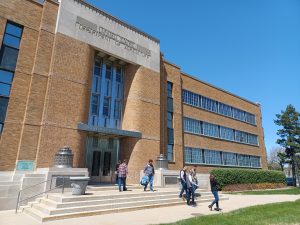RFD NEWS & VIEWS: Dry millers conference returns to Peoria
By Tim Alexander for Chronicle Media — May 16, 2023
Peoria’s USDA “Ag Lab,” officially known as USDA’s National Center for Agricultural Utilization and Research, will host NAMA’s annual Corn Dry Milling Conference June 21-22. (Photo by Tim Alexander)
This week we have updated Illinois livestock numbers to share with you, and we’ll catch up on the business of wheat and corn milling. We’ve also got news about why more soil conservationists will be hired in Illinois. Please read on …
Illinois livestock numbers updated
SPRINGFIELD — New data published by the USDA’s National Agricultural Statistics Service reveals that Illinois is home to an estimated one million head of cattle and calves. According to NASS’ May 8 Illinois Cattle County Estimates report, the rolling hills of Jo Daviess County in the northwestern corner of the state is home to the most cattle, with an estimated 50,000.
The next-closest county, Stephenson, is host to 38,000 calves and cattle. Rounding out the top five most populous Illinois counties for bovine are Clinton (37,500), Adams (34,500) and Carroll (27,500) counties.
For a glance at current prices paid to the state’s livestock producers, visit the USDA’s Illinois Weekly Cattle Auction Summary at www.ams.usda.gov/mnreports/ams_2041.pdf.
Tour will examine wheat crop quality
BLOOMINGTON — Farmers, flour millers, seed industry representatives and others will examine the potential of this year’s winter wheat crop in Illinois during the Illinois Wheat Association’s annual Southern Illinois Wheat Tour, to be held May 23. According to the Illinois Farm Bureau, the event will begin in the morning with four teams of scouts checking fields throughout southern Illinois and conclude with a wheat plot tour at the Southern Illinois University Belleville Research Center that afternoon.
“For a flour miller, it’s very important to get out there and see what type of crop we’ve got and what type of disease pressure we may have. We’re mostly concerned about vomitoxin” through head scab,” Mark Miller of Mennel Milling Company in Mount Olive told IFB’s FarmWeek.
Tour participants will drive through each portion of southern Illinois, visit four research sites, sample the crop and collect data. Data and notes will be compiled and discussed at the day’s end in Belleville, where the meeting portion of the event will begin at the Southern Illinois University Belleville Research Center at 4 p.m. There, guest speakers will walk participants through the SIU research plots and tour leaders will discuss findings from each of the regional tours.
Registration is free for the event; however, reservations are strongly encouraged. Contact IWA at 309-557-3268 or email contact@illinoiswheat.org. Visit the website, illinoiswheat.org, for more information.
Dry millers conference returns to NCAUR
PEORIA — Speaking of millers and processors, the Corn Dry Milling Conference, co-sponsored by the North American Millers’ Association and the U.S. Department of Agriculture’s National Center for Agricultural Utilization Research, will return to Peoria’s USDA “Ag Lab” June 21-22. Since 1959, the conference has provided a forum for the entire value chain to share the latest milling and processing research.
“If you’re involved in the corn milling value chain, you don’t want to miss out on the insights that will be shared at this year’s Corn Dry Milling Conference,” said NAMA President Jane DeMarchi. “NAMA is proud to continue our longstanding partnership with NCAUR to highlight relevant, impactful research that supports the corn sector from the farm to the mill and beyond.”
CDMC will kick off with an opening reception and dinner on June 21, with a full day of programming to follow at NCAUR on June 22. The event features a wide range of topics including a focus on mycotoxins, testing methods, breeding technologies and speakers from academia and the private sector.
For more information on the conference, contact generalinfo@namamillers.org or 202-484-2200.
NRCS hiring soil conservationists
CHAMPAIGN — As part of increased efforts to defeat soil erosion and farm nutrient losses, the USDA’s Natural Resources Conservation Service is actively hiring soil conservationists in Illinois and the Midwest using funding from the federal Inflation Reduction Act. The job openings are part of a broader effort by NRCS to help producers develop conservation plans and implement conservation practices, including critical climate-smart practices.
“The Inflation Reduction Act represents the single largest investment in climate and clean energy solutions in American history, and NRCS’ programs are an important part of our efforts,” said Tammy Willis, Acting State Conservationist for NRCS in Illinois. “To help agricultural producers invest in conservation on their farms and working forests, we need to grow our team that delivers our conservation programs in Illinois. This next generation of conservation professionals will help us build upon our long history of working one-on-one with producers to get conservation on the ground.”
According to Willis, NRCS soil conservationists offer conservation planning and technical help to agricultural producers, helping them implement practices that sequester carbon, mitigate against climate change, and conserve other natural resources. Their assistance helps producers approved for USDA-NRCS’ Environmental Quality Incentives Program, Conservation Stewardship Program, Agricultural Conservation Easement Program, Regional Conservation Partnership Program and others.
$19.5 billion has been earmarked from the IRA for conservation programs in Illinois, according to a May 10 Illinois NRCS news release. In addition to hiring additional soil conservationists, NRCS is working with partners to hire nearly 3,000 independent team members in the coming years. The contracted employees will play a critical role in the conservation planning and implementation process, complementing the work done by NRCS employees.
Illinois Farm Fact:
May 26 is the deadline to sign up for USDA-NRCS’ Grassland Conservation Reserve Program, a unique program that allows farmers and landowners to continue cutting hay and grazing livestock while conserving grasslands and promoting biodiversity. (Illinois USDA-NRCS)







